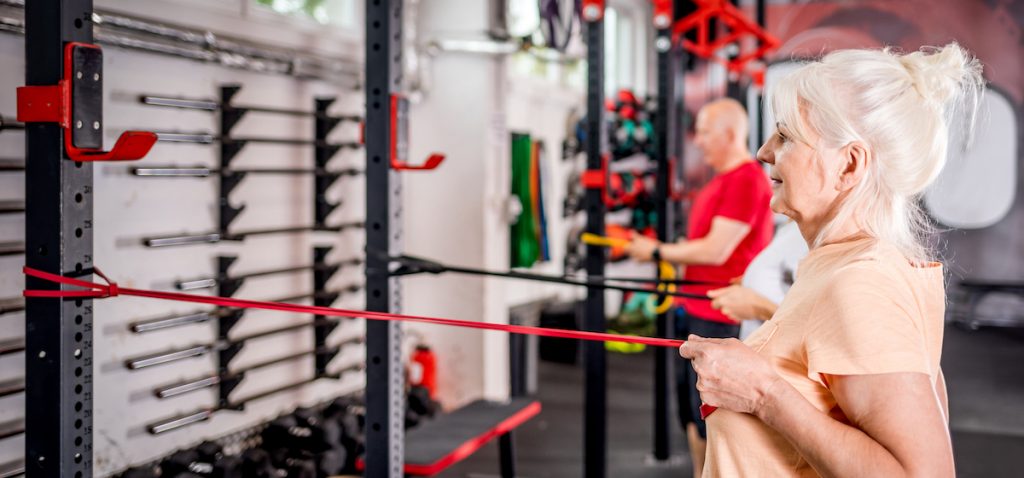Although there are numerous differences between the bodies of men and women, our muscle tissue is very similar. Age-related muscle loss is a natural part of aging and both sexes lose around two kilograms of muscle each decade after the age of 30.
Most men will lose about 30 per cent of their muscle mass during their lifetimes. But since men naturally have more muscle than women, this loss can particularly affect females.
Men also tend to have larger skeletons, meaning bone loss typically begins later in life and progresses more slowly than it does for women. The good news though, is that both sexes can reap the benefits of weight training, including increased muscle strength and size, improved balance, stronger bones, faster metabolism and a leaner physique.
It has also been shown to help improve sleep, sense of wellbeing, and decrease the risk of injury.
Differences between men and women
Females naturally produce smaller amounts of testosterone, which prevents them from developing huge muscle mass. Some women avoid strength training to avoid looking bulky but lacking muscle mass is linked to having less bone mass, which can raise your risk of osteoporosis.
Plus, as oestrogen levels drop with the onset of menopause, the loss of bone mass increases rapidly, causing signs of osteoporosis to appear earlier for women (age 40-65) than for men (age 65). Strength training can help keep a woman’s muscle mass as high as possible for longer.
In men, testosterone is not only responsible for increased muscle mass, but it also contributes to stability, balance and endurance. Men produce higher levels of testosterone than women, but they can’t rely on this natural advantage. Loss of muscle mass, muscle weakness and bone fractures can occur when testosterone levels decline with age. Adding resistance training to your exercise regime can help avoid or delay this decline.
The study
Now, a new study led by UNSW Sydney shows men and women aged over 50 can reap relatively similar benefits from resistance training.
The findings consolidated the results of 30 different resistance training studies involving more than 1400 participants. This paper specifically compared the results of men and women aged 50 and over.
“Historically, people tended to believe that men adapted to a greater degree from resistance training compared to women,” says Dr Amanda (Mandy) Hagstrom, exercise science lecturer at UNSW Medicine & Health and senior author of the study.
“The differences we found primarily relate to how we look at the data – that is, absolutely or relatively. ‘Absolute’ looks at the overall gains, while ‘relative’ is a percentage based on their body size.”
The paper is the first systematic review and meta-analysis to examine whether older men and women reap different resistance training results. The findings add to past research on differences in younger adults (18-50), which suggested that men and women can achieve similar relative muscle size gains.
The researchers compared muscle mass and strength gains in 651 older men and 759 older women across the 30 studies. The participants were aged between 50 and 90, with most having no prior resistance training experience.
While 50 is not typically considered an ‘older adult’, it was selected as the threshold for this study given the potential for menopausal hormone changes to influence resistance training outcomes.
“We found no sex differences in changes in relative muscle size or upper body strength in older adults,” says Dr Hagstrom.
“It’s important for trainers to understand that women benefit just as much as men in terms of relative improvement compared to their baseline.”
Sex-specific workout tips
Older men tended to build bigger muscles when looking at absolute gains, the researchers found. They were also more likely to see greater absolute improvements to upper and lower body strength.
But when it came to relative lower body strength, older women saw the biggest increases.
“Our study sheds light on the possibility that we should be programming differently for older men and women to maximise their training benefits,” says Dr Hagstrom.
The team conducted a sub-analysis of the literature to see what resistance training techniques gave the best results for each sex.
“Older men might benefit from higher intensity programs to improve their absolute upper and lower body strength,” says Dr Hagstrom.
“But older women might benefit from higher overall exercise volumes – that is, more weekly repetitions – to increase their relative and absolute lower body strength.”
Longer training durations could also help increase relative and absolute muscle size (for older men) or absolute upper body strength (for older women).
“Changes to exercise regimes should be made safely and with professional consultation,” says Dr Hagstrom.
Strengthening future health
“Strength training is very important and beneficial to our health – especially for older people,” says Dr Hagstrom.
“It can help prevent and treat many age-related chronic diseases, like diabetes, heart disease and arthritis.”
Dr Hagstrom hopes her future research can identify more best-practice prescriptions for resistance training exercises.
“Learning more about resistance training and its benefits could help improve overall health outcomes for Australia’s ageing population,” she says.
Do you incorporate resistance training in your exercise regime? Do you enjoy strength training or prefer cardio?
If you enjoy our content, don’t keep it to yourself. Share our free eNews with your friends and encourage them to sign up.
Materials provided by University of New South Wales. Originally written by Sherry Landow. Note: content is edited for style and length.
Related articles:
https://www.yourlifechoices.com.au/news/how-to-strength-train-safely
https://www.yourlifechoices.com.au/health/wellbeing/the-dos-and-donts-of-lifting-weights-if-youre-older
https://www.yourlifechoices.com.au/health/wellbeing/fitness/who-guidelines-on-physical-activity

